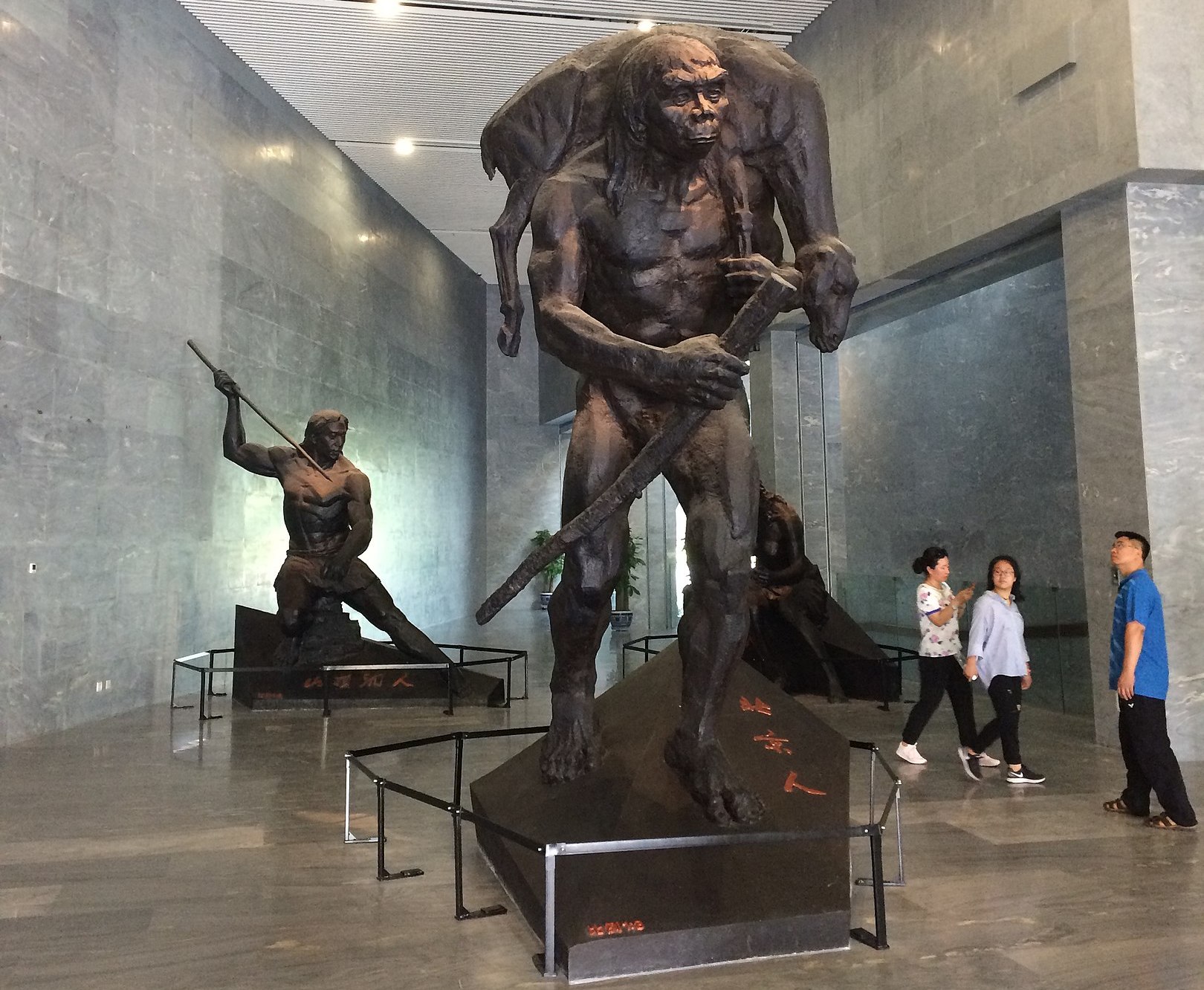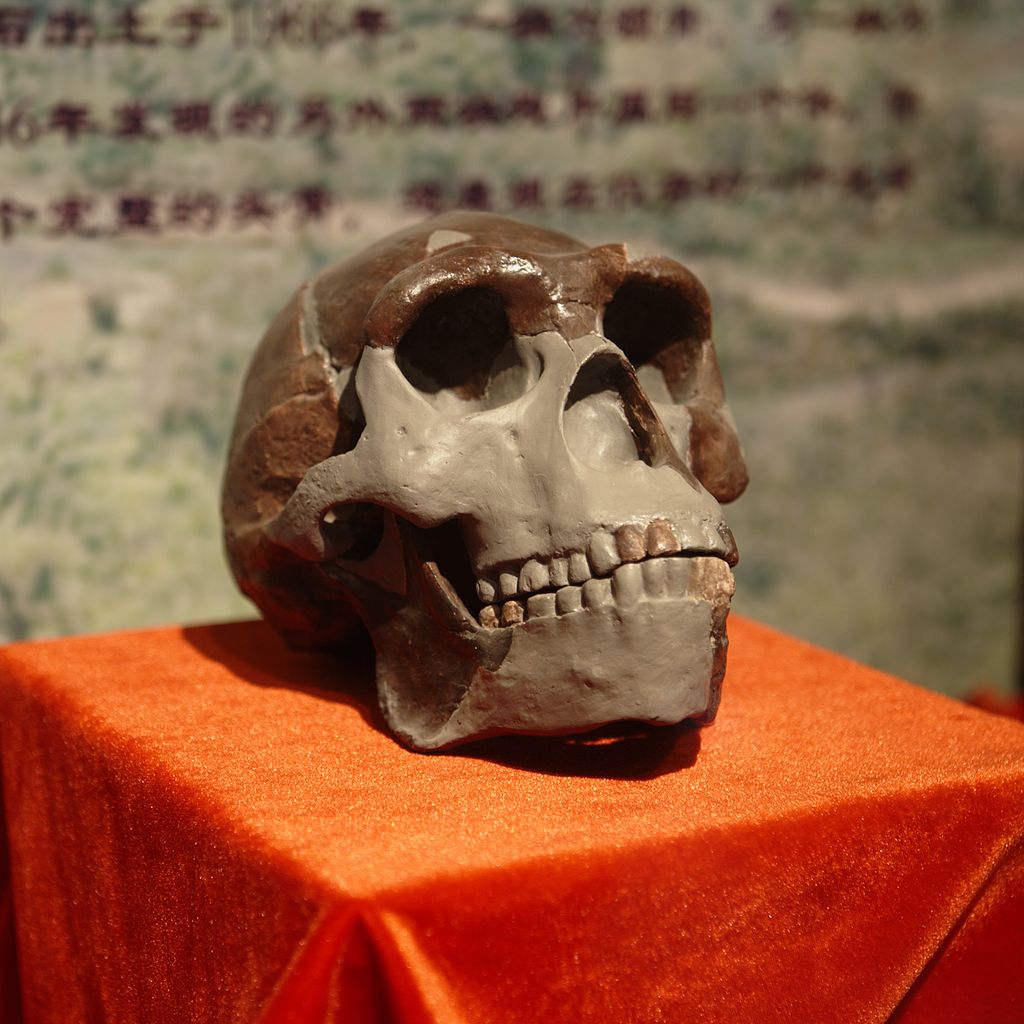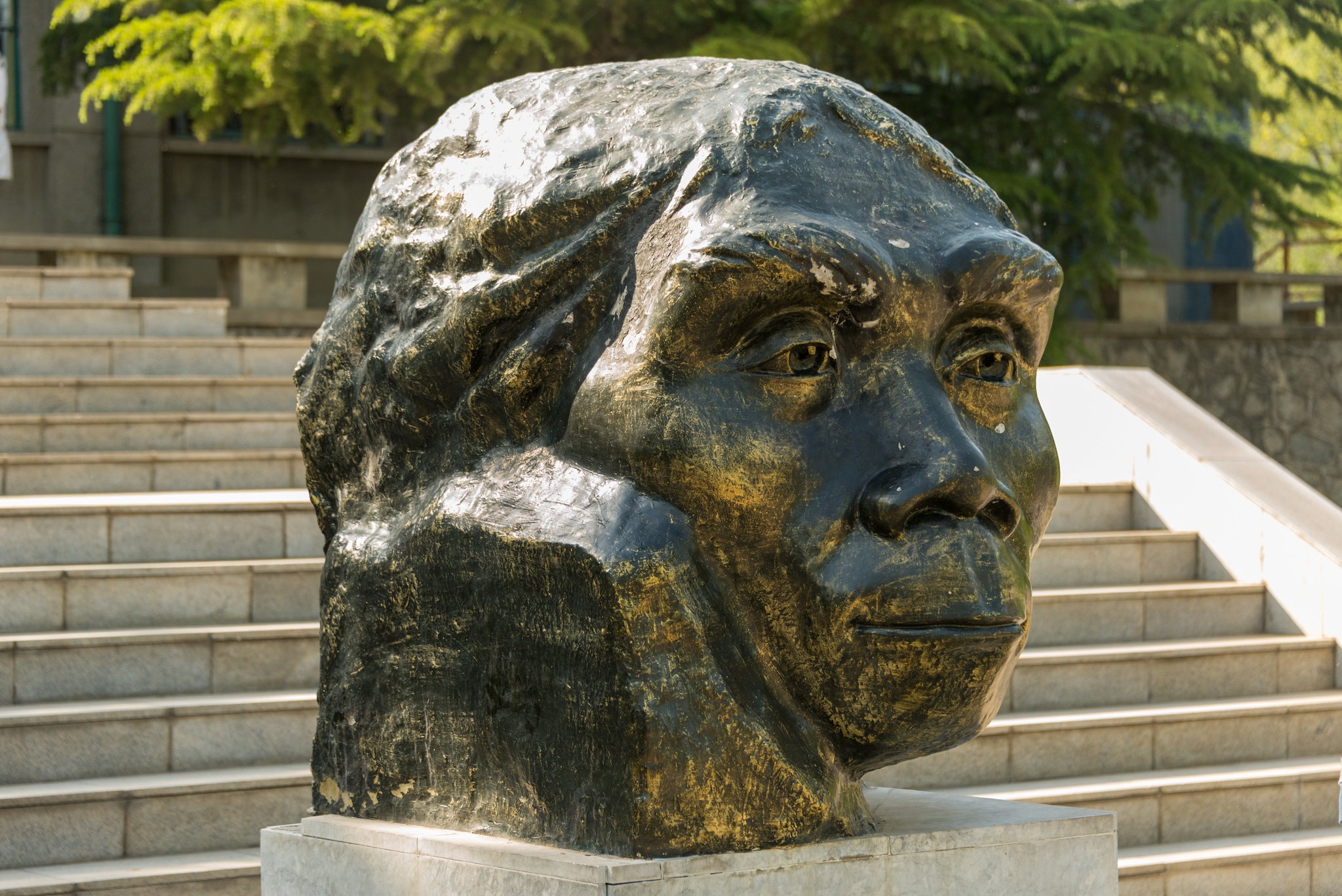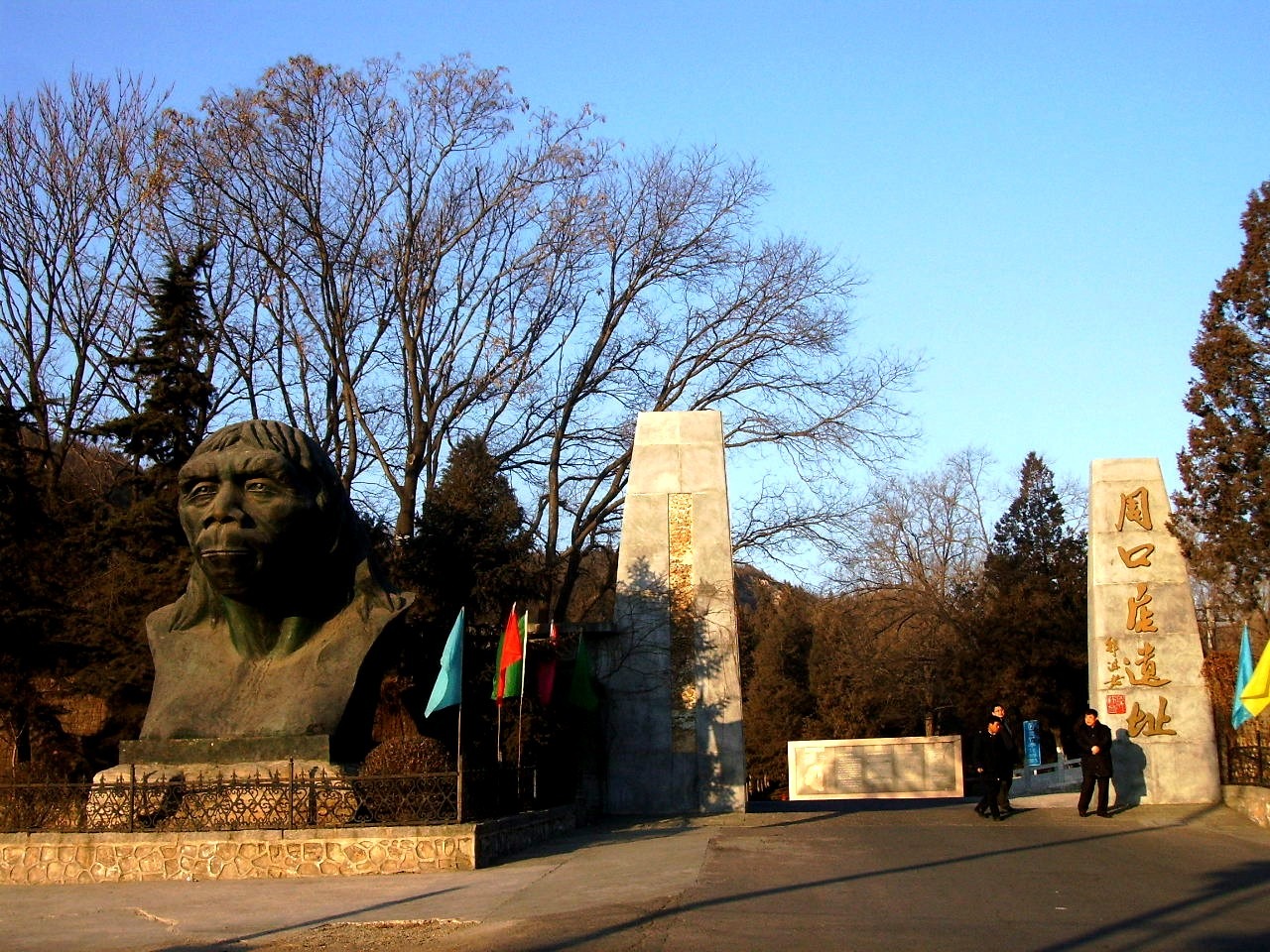Peking Man and Chinese Superiority

By Thomas Lambert
Staff Writer
28/8/2020

Statue of Peking Man at Zhoukoudian Site Museum (Picture Credit: BleachedRice)
It all began at Dragon Bone Hill. It was not the remains of the giant hyena that caused a stir, though it stood 40 inches at the shoulder, nor the fossilised Zhoukoudian wolf, nor even the fragments of sabre-toothed tiger. What really set the anthropological world spinning was a gem of lime-polished enamel, less than a centimetre across: a molar, protruding from the cliffside. A human tooth. Its owner, whom the international press dubbed “Peking Man,” would one day be appropriated as a symbol of Chinese supremacy.
Dragon Bone Hill is not a hill at all, but a deep cave, part of an ancient cave network called Zhoukoudian, which is located 40 km southwest of Beijing. Today, it houses a gleaming education centre and a parking lot for coachloads of schoolchildren, but when Swedish geologist Johan Gunnar Andersson and American palaeontologist Walter W. Granger first stumbled upon it in 1921, it was a backwater, nestled between traditional farms. It took months to find that first tooth. And yet, as the twenties wore on, discoveries became more and more regular, until by the end of the decade Zhoukoudian was the epicentre of a global paleontological collaboration, a hunt for the origins of man. But the most extravagant claim was yet to come. By 1928, the Canadian anatomist Davidson Black had pieced together Granger’s molar with innumerable fragments of cheekbone and jaw, dubbing the result Sinanthropus pekinensis: four or five feet tall, beetle-browed, with a flattened head and an unusually large brain. A new species of human, native to China.

Replica of Peking Man’s skull at the Paleozoological Museum of China (Picture Credit: Yan Li)
Under the stewardship of Chinese archaeologists, excavations continued apace for another decade, right up till the Japanese occupation in 1937. Most remarkable of all the finds were the skulls: at least 12 of them, male and female, young and old. They were largely in fragments, but still discernibly human. Overseas, the excitement grew steadily. Amid the chaos of the Second World War, it was decided that the fossils would be moved from Union Medical College in Peking to a safer location, and so in 1941, they were loaded aboard an American ship bound for the American Museum of Natural History in New York. But here began the first mystery in the saga of Peking Man. Neither the fossils, nor the ship, ever arrived. Some say the bones were stolen before they reached the ship; some say they were buried while the port was under siege; most believe they lie at the bottom of the ocean. But whatever happened, the great lacuna they left has only whetted the popular appetite for Peking Man in China. His legacy grows stronger and stranger with the years, and even if the questions posed about China’s past by this handful of bones are intractable, the controversy they’ve spawned is crucial to answering many we may have about China today.
The first real Peking Man enthusiasts were Westerners. No sooner had the fossils vanished than European anthropologists began to concoct elaborate new theories of human evolution, all with Peking Man at their centre. The most famous of these was a German, Franz Weidenreich. To Weidenreich, Peking Man was not just a crude, hominid precursor to Homo sapiens, similar to Homo erectus, whose remains have now been found from Java to the Iberian Peninsula, but was rather that most coveted prize of palaeontology, a “missing link.” Instead of humans having evolved in Africa, before migrating into Asia (as had been the consensus since Darwin), Weidenreich believed they had evolved separately as different races, in different regions of the world, before converging over thousands of years. In Peking Man, it seemed, the Chinese had their original ancestor, their patriarch.
In Peking Man, it seemed, the Chinese had their original ancestor, their patriarch.
Weidenreich’s theory fit perfectly with some of the wackier prejudices of colonial anthropology, and so it was little surprise that by the 1950s it had gained considerable popularity in the groves of European academe, not to mention at the vanguard of the New Age movement. But China – now in the thrall of Mao – was a different story. Weidenreich’s heirs at Union Medical College were met with apathy from the Chinese government, and outright ridicule from the other universities. Peking Man was unwanted. Chinese anthropologists like Zhu Xi even went so far as to suggest that the facial features of Peking Man had been closer to Europeans than Chinese, and hence should not be considered an ancestor to the Chinese race, but to the European one. The implication was clear: the modernising, reforming China of the Great Leap Forward would have nothing to do with the antiquated world of Peking Man. All factions of the Chinese Communist Party and Politburo, from the firebrand Mao to the relatively moderate Liu Shaoqi, agreed that China’s priority must be to transition away from traditional agriculture and towards an industrial society. A country so obsessed with the future was not interested in looking back.
Around the end of the Cold War, the tide of European opinion began to change. Fewer and fewer Western anthropologists took Weidenreich seriously. In the 1990s, the Human Genome Project (HGP), spearheaded by the US, threatened to confirm the “out of Africa” thesis for good. Analysing mitochondrial DNA passed down the maternal line, the HGP found evidence of shared origins between isolated communities of indigenous Africans and every other major human ethnic group. Peking Man, by contrast, was shown to be a member of the early hominid species Homo erectus, and, as such, evolutionarily distinct. The notion of a single human evolutionary origin seemed to suit the politics of the period too: optimistic, universalistic, with a democratic emphasis on what all humans had in common. In China, during the first, relatively liberal, few years of Jiang Zemin’s premiership, there was considerable Chinese receptivity to the “out of Africa” thesis. The Chinese signed up to the HGP in 1993, under the influence of the eminent geneticist Tan Jiazhen, whose most well-known report, “Genetic Relationship of Populations in China,” was notable not simply for its assertion of the African origin of the ethnic Chinese, but for its insistence on the shared origins of different ethnic groups within China – not only among the Han majority, but between Hui, Uyghur, Manchu, and Tibetan enclaves. To be Chinese, circa 1993, was to be a citizen of the world.
As the new millennium drew closer, however, something else that had been buried began to recrudesce. The late 1990s saw an explosion of nationalism in China, and with it, a new emphasis on ethnicity, morphology, and race. In the past, Mao’s condemnations of “Han chauvinism” had tempered the more belligerent sections of the Han majority; now, a vociferous Han middle class clamoured for formal recognition of its dominance. Peking Man was caught up in this shift. The debate surrounding the missing bones fractured into two distinct camps. On one side were the Chinese geneticists, who followed the “out of Africa” thesis popularised by Tan Jiazhen; on the other, growing ever more influential, were anthropologists like Wu Xinzhi, seeking to rehabilitate the notion of a separately evolved Chinese race.
The late 1990s saw an explosion of nationalism in China, and with it, a new emphasis on ethnicity, morphology, and race.
The nationalistic undertones of Wu’s study are palpable. Whereas Tan had concentrated primarily on genetic sequencing, Wu’s evidence was a descendant of 19th-century race theory. He revived the practice – pioneered by Samuel George Morton, the doyen of American scientific racism – of taking “craniometrical” measurements between different points on the skull, and using differences to sort humans into different races. Ironically, this Chinese shift in emphasis from genotype to phenotype was European in provenance: Wu developed his ideas in conjunction with the American anthropologist Milford Wolpoff, one of the main espousers of Weidenreich’s model. Accordingly, Wu noted Peking Man’s “flat front face but projecting cheekbones, shovel-shaped incisors, a low nasal bone, and rectangular-shaped eye sockets.” Peking Man, to Wu, simply looked Chinese.

Peking Man bust (Picture Credit: xiquinhosilva)
Though seriously flawed, Wu’s lines of argument were welcomed by the Chinese establishment. The reasons were, of course, political. After the US bombing of the Chinese embassy in Belgrade in 1999, deteriorating relations between the two superpowers had made Chinese universities suspicious of the US-led Human Genome Project , and, by extension, of the discipline of genetics itself. Wu’s theories not only pandered to the new nationalism on an emotional level, they also offered a new methodology, one free from the taint of Western, cosmopolitan politics. Within an increasingly polarised academic establishment, Peking Man became a kind of shibboleth: to view him as an ancestor of the Han Chinese was to acknowledge China as a special case in the development of human civilization, while to view him as an evolutionary dead-end was to betray Chinese nationalism in favour of a universalist view of a common humanity.
To view Peking Man as an evolutionary dead-end was to betray Chinese nationalism in favor of a universalist view of a common humanity.
Wu’s most vocal acolyte, Gao Xing, demonstrated this politicisation admirably. In a 2010 summary of the debate, Gao likened foreign species of hominid that had travelled to China “out of Africa” to “short-lived blossoms,” which “failed to leave any significant influence on native mainstream culture.” Reading Gao’s account, the veil covering a sense of Chinese superiority soon wears thin: “the main group of ancient humans during the Pleistocene era in China and even in East Asia had continued to thrive,” we are told, “never experiencing any disruption” since “its culture had powerful vigour for life and presented a successive evolutionary relationship.”
To non-Chinese readers, of course, this might all seem a bit abstruse. Why should it matter, this dispute between academics, this row among the cloisters? But Peking Man is no longer the sole property of geneticists and anthropologists. As the US-based historian Yinghong Cheng has noted, since the turn of the millennium, Peking Man has been appearing more and more frequently at state events, as a symbol of China’s cultural unity and the Chinese people’s unique ancestry. His invocation on television or social media sets keyboards tapping, and even the kitschiest public likeness draws crowds. On the final day of 1999, actors dressed in caveman costumes lit a torch in the Zhoukoudian caves. A troupe of Chinese athletes then carried that torch to Beijing, where it was used to kindle the burning altar at the China Centennial Monument – a great, terraced structure pitched somewhere between satellite dish and Sumerian ziggurat – meant to herald the new “China century.” A similar ritual began the 2008 Olympic torch relay – minus the loinclothed actors, but with the addition of a bronze bust of Peking Man at the foot of the handover ceremony’s red-carpeted rostrum, displaying all the phrenological quirks prized by Wu.

Zhoukoudian Peking Man Site (Picture Credit: Mutt)
But there’s a darker side to all this popular enthusiasm. In his 2017 paper “Is Peking Man Still our Ancestor?” Cheng charted an astonishing groundswell of online abuse over the preceding few years, directed overwhelmingly at Chinese geneticists and advocates of the “out of Africa” theory. Journals that dare to question Peking Man’s status as Chinese progenitor face storms of vituperation: National History, a Chinese publication which Cheng describes as an “avant-garde popular-history journal with a liberal tendency,” is frequently dismissed as a “banana” – the racial epithet suggesting a “white core” belied by the publication’s “yellow skin.” One comment makes the accusation even more explicit, accusing Chinese geneticists of a “national nihilism and Western universalist values.”
Perhaps even more worrying is the slide among the Chinese media, into more and more explicit assertions of racial superiority. In particular, a hostility towards the notion of an African origin of the Han Chinese race has begun to morph into a hostility towards Africans themselves. Popular essayists like Wang Sixiang ridicule the notion that “our ancestors” could have been “wiped out by Africans,” and ask if Chinese people should start singing songs that go “Oh, Africa, my dear motherland.” Cartoons depict patriotic Peking Man tussling with swarthy, African-looking Homo sapiens, usually with exaggerated racial features. Nor is this an isolated phenomenon: the furore surrounding Peking Man is increasingly representative of what is going on in China as a whole. Last year, anti-African sentiment bubbled over into outright violence against foreign workers on the streets of Guangzhou. Racist traditions from the West, despite having no history in China, are now suddenly all the rage: in 2018, the world’s most watched TV show – CCTV’s Spring Festival celebration – featured characters shuffling about in blackface, complete with a false-buttocked matron and a black actor in a monkey suit with a basket on his back. Separateness cannot, it seems, sustain equality.
The desire to be different, the search for distinct racial origins, even the ridicule of those who do not share them, are nothing new. In 1912, English anthropologists dubbed a fossilized skeleton, known as “Piltdown Man,” “the first Englishman,” even comparing an accompanying elephant bone to his cricket bat. In 1953, Piltdown Man was proved to be a hoax, the composite of a medieval human skull, the mandible of a 500-year-old orangutan, and the fossilized teeth of an ancient chimpanzee. The same happened with a cache of bones in Japan, “discovered” by Fujimura Shinichi in 2000. What is curious, though, is the way the most fundamental of scientific questions – where we come from – has been dominated by caprice; the way we subordinate it, unfailingly, to the demands of nation, pride, and self-image.
What is curious is the way the most fundamental of scientific questions – where we come from – has been subordinated to the demands of nation, pride, and self-image.
This is, perhaps, as true of the Human Genome Project as it is of the snarling polemics of Wang Sixiang or Gao Xing. The liberal preference for geneticists over anthropologists, for the evolution of the Chinese race “out of Africa” over “out of China,” is only in part empirical. In the West, the “out of Africa” thesis owes its sway not to a widespread understanding of the intricacies of genomic science, but to the trenchant political style of vulgarisers like the famous palaeontologist Stephen Jay Gould. The most successful book on the subject in the West, Gould’s bestselling The Mismeasure of Man, argues against the morphological method adopted by Chinese anthropologists like Wu. But it does so less by citing evidence of common features between races, than by engaging in a Marxist critique of what Gould calls the “reification” of racial concepts. It is no surprise, then, that in the mainstream press, The Mismeasure of Man was met with rapturous approval, while reviews in scientific journals were, on the whole, extremely critical. Gould championed equality, and this was what drove his conviction that we all come from the same place. Few, if any, are above this: ideology plays handmaiden to fact, and we find ourselves believing in a human origin that suits our moral purposes, whatever they may be.
In countries other than China, “out of Africa” is indeed the scientific consensus. Even if we believe it for the wrong reasons, the evidence is there: the discipline of anthropology has yet to come up with a credible riposte to the genomic studies carried out by Tan Jiazhen. But to collapse these matters of principle into matters of fact is a mistake. As long as our values are susceptible to a new stone tool, a new barrow of bones, or even a new interpretation of genetics, they are fragile as the remains themselves, and just as easily lost. This is the great truth that the quarrel over Peking Man belies. Equality between the races, or that ephemeral thing, a “common humanity” – these are to be asserted, not derived. Such axioms, the very stuff of humanity, are far too precious to depend on whence that humanity came.
